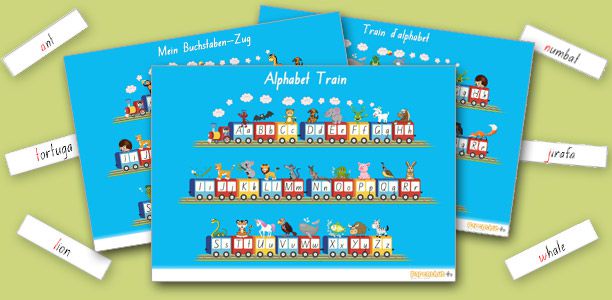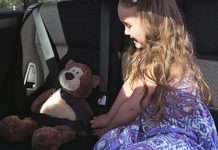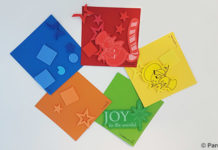Age
2-8 years
Duration of activity
You can spend just a few minutes or up to an hour singing the ABC song and doing these activities.
Cost
Nil
Preparation
- Familiarise yourself with the ABC song lyrics if you do not already know them. If you already know the ABC song, you do not need to prepare anything.
- Print out, laminate (optional) and hang the Alphabet Animal Train so that your child can look and/or point at the letters as you sing.
What to do
Singing the ABC song
- This activity is suitable for children aged two to six years
- Sing the ABC song for your child if they have not already started learning to sing it.
- Tell your child that the alphabet contains letters and all letters make different sounds. Today you will teach them the ABC song which will help them learn the names of the letters. Later you will teach them the sounds each letter makes and how to write and read letter.
- Show your child the alphabet animal train and explain to them that each carriage of the train contains a different letter of the alphabet and the name of the animal in each train carriage starts with that letter.
- If your child already knows some letters of the alphabet, for example the first letter of their name, ask them to point to and name the letters that they already know.
- Next sing the song with your child.
- Sing slowly and encourage them to pronounce the individual letter names clearly and accurately. This is especially important for letters that have similar names, for example b and v, and for letters which are spoken quickly during the song (e.g. l, m, n, o, p).
- When you finish singing the song, ask your child which letters they remember singing and if for example they remember singing the first letter of their name.
- Repeat the song several times to help your child memorise it. At first they will probably only remember the start of the song (e.g. abcd).
- Repeat this activity every day until your child knows all the letter names
Singing the ABC song and pointing
- This activity is suitable for three to six year olds.

- You will need an alphabet animal train, hung at your child’s eye level to do this activity.
- Alternatively you could use a set of alphabet flashcards, placed on the floor in alphabetical order. Hang or place them somewhere that your child can see them easily and reach to point to them. For example you might:
- Peg them to a length of string hung between walls;
- Place them on the floor;
- Stick them on the wall at child height.
- Before you start singing, ask your child to look at all the letters and point to any that they already know. For example they may know the first letter of their name.
- Explain to them that they are looking at all the letters of the alphabet and these letters make all the different sounds we need to say words and talk to each other. By writing them down in different combinations as words we can tell other people what we are thinking without speaking (and they read instead of listen).
- Tell them that today you will learn to recognise the letters of the alphabet and sing a song that includes the names of all the different letters and point to the letters as you sing. To excite their desire to learn, tell them that once they learn the letters you will teach them how to read and write words, so that they will be able to write letters to friends and read books.
- Now ask them to sing the alphabet song. As they sing the name of each letter, point to (and/or ask your child to point to) the corresponding letter on the alphabet animal train. Sing with them to help them pronounce the letter names properly (especially in tricky parts of the song like the letters l, m, n, o, which are sung very quickly). Sing slowly so your child has time to move their finger (or a pointer- they may enjoy using a ruler or something else) to point to the letters.
- When you have finished singing ask your child to point to any letter they remember and say the name.
Singing the ABC animals chant and pointing
 This activity is suitable for 3-6 year olds.
This activity is suitable for 3-6 year olds.- You will need an Alphabet Animal Train and lyrics for the ABC animal chant to do this activity. You may also like to use a ruler or other instrument to point to the carriages on the alphabet animal train as you sing.
- Hang the animal train at your child’s eye level.
- Explain to them that today you will sing a chant that will help them learn the letters of the alphabet and they sounds they make. Tell them that the letters of the alphabet make all the sounds we need to say words when we speak to other people. Explain that letters can also be written as words on paper.
- Tell them that the animal train has one carriage for each letter of the alphabet and in that carriage lives an animal that’s name starts with the same letter. Explain to them as you sing the alphabet chant together they should look or point at the carriage containing the letter they are singing.
- If your child is not already familiar with the alphabet chant, sing it for them. If they are already starting to learn the chant, let them sing themselves and sing with them to help if they get stuck.
- When you have finished ask your child to try and remember different letters and animal names that start with those letters. For each letter ask them if they can think of another animal or word that starts with the same letter.
Singing the ABC songs with object from around the house
- This activity is suitable for 3-6 year olds.
- You will need a range of toys or household objects starting with different letters of the alphabet to do this activity. Try to find objects with short name (e.g. a mat rather than a piece of macaroni) as these will be easier for young children who are just starting to learn. Or you could use photos of friends and family members whose names start with the letter.
- To begin, sing the alphabet song with them, making sure you sing slowly and pronounce the letters clearly as you sing.
- Tell your child that today you will start learning about things that start with different letters of the alphabet.

- First you will learn about things starting with the first letter of the alphabet. Ask your child what the first letter of the alphabet is. If they don’t know, tell them it is the first letter they say when they start singing and ask them to start the alphabet song.
- Once you have identified letter a as the first letter of the alphabet, show them the object beginning with letter A (e.g. an apple). Now sing the alphabet song and point to the apple (or whatever A object you are using) as you sing.
- Now ask about the next letter of the alphabet. When your child has identified letter B, show them your B object (e.g. a ball). Place it to the right of the A object.
- Sing the alphabet song again, pointing to the A object as you sing A and the B object as you sing B.
- Continue for other letters of the alphabet. You could make a line of objects for every letter of the alphabet. If your child is just starting to learn, concentrate on the first few letters.
Tips and extension activities
- To help your child also learn to recognise the written letters, do this activity with a set of lower case letter alphabet flashcards. As you place each object in the line, place the corresponding letter next to it.
- For older children who are already starting to know words for objects starting with different letters of the alphabet, get them to find the objects themselves. Using alphabet toy boxes is a great way to help young children find objects beginning with different letters (and a great way to encourage them to clean up their toys after themselves).
Musical alphabets
- Similar to musical chairs but played singing the ABC song- when the music stops, your child or children have to find something starting with the last letter you sang.
- This game is suitable for children aged 4-8 years who can already identify the starting letter of words for objects.
- It is a great game to play with a group of children and lots of fun to play outdoors.
- To prepare find several different objects starting with each letter of the alphabet (or just a few letters, for example the letters of your child’s name) Place them randomly in the yard or inside, but close enough together that your child can easily see them.
- If you are playing outside with older children you do not need to find objects. Challenge the children to find something in the natural environment that starts with the last letter you sang.
- Explain to your child that you will sing the alphabet song and they need to listen very carefully as you sing each letter. When you stop singing they have to pick up an object starting with that letter.
- If you are playing with a group of children that know the alphabet song they might like to take it in turns singing and choosing which letter to stop on. Or the first child to find the object when singing stops on a letter could be the one to sing next.
- Sing the ABC song and stop before the end. Remember which letter you stopped on.
- If you are playing with older children, they should look around for an object starting with the last letter you sang (e.g. if you sang a, b, c, d, e, they might pick up an egg or an elephant).
- If you are playing with younger children, you may need to help them a bit, by first getting them to say the letter name, then getting them to say the sound that letter makes (helping them if they have trouble) and then finding the object.
- Repeat for all the letters or until your play time runs out.
Educational outcomes
Literacy and language skills
Learning the names of the letters in the alphabet, to recognise the written letters and associate each letter with a particular sound or sounds is an important foundation for future literacy, that is the ability to read and write. These alphabet activities also help develop your child’s oral language skills like the ability to pronounce sounds correctly and combine the words they know in sentences.
Listening and speaking skills
Singing songs like the ABC song and the alphabet animal chant is a great way for children to practice pronouncing words and letter sounds clearly and accurately, and develop their understanding of spoken language. They will also develop their language skills as they talk and listen to you and follow the instructions you give them throughout the activities. For example they’ll be learning new words and sounds and practicing how to put words together in sentences and they ask and answer questions and discuss the alphabet. Pay attention to your own pronunciation and grammar. Pronounce words clearly and speak in clear, simple sentences which are appropriate for your child’s age.
They’ll demonstrate their language skills are developing as you repeat these activities over time, for example by:
- Following the instructions you give them;
- Participating more and more each time, for example at the start they may sing just a few letters of the ABC song with you; after practice they’ll be able to sing the entire song on their own;
- Naming objects using appropriate words; and
- Increasing the clarity of their pronunciation of sounds and words.
Letter-name recognition
Letter-name recognition is the ability to recognise the shape of each letter of the alphabet and say the name of the letter. Children often learn letter names by singing the ABC song. This often occurs before they learn the sounds associated with each of the different letters. Being able to see the shape of the written letters as they sing helps children understand the association between the name of the letter and the shape they see written on paper.
Letter-sound association
Letter sound association is the ability to associate a particular spoken sound with a corresponding written letter. It is the basis for later reading and writing ability. Research shows that when a person reads they look at and process each different letter written on the page to sound out the words (even though a good reader will do this so quickly they are not even conscious they are doing it!). Unless children master their knowledge of the letter shapes and the different sounds each letters makes, they will struggle to combine them to write words, or work out the sound of written words when they are reading. Activities like these help children make the associations between different letters and their sounds.
Literacy skills
Literacy or the ability to read and write is critical for children’s later educational success- if they can’t read and write they will struggle to access the knowledge they need to learn (e.g. information contained in books) and to express their ideas in writing (e.g. in essays at school). Learning to recognise and read individual letters is a critical foundation for literacy and singing alphabet songs and chants is a great way to help them master the letters.
As they do the activities they will also be introduced to other important literacy concepts, for example:
- They will learn that letters are symbols which can be written down and combined as words that have the same meaning as spoken words, that is that printed text represents the words we speak. This early awareness of printed text typically comes at about four years of age;
- They will learn that when writing letters they should start at the left and move to the right in the same way that a reader would read text starting at the left of the page and moving to the right of the page.
Mathematical skills
Although these activities are primarily for developing children’s language and literacy skills, they also help develop and reinforce a range of mathematical concepts, including shape, patterns and relationships and one to one correspondence. As they look at the letters of the alphabet they will be looking at different shapes and probably also using mathematical words to describe the shape of letters (e.g. describing the lines and straight or curved) and the similarities and differences between them. Putting together corresponding objects, letters and sounds helps teach children about matching and how different objects can be matched based on relationships, in this case between the letter and sound. They will also learn about one to one correspondence an important concept for developing counting and number skills, when they match one letter to one object.
Fine motor skills
Picking up small objects, for example objects starting with different letters of the alphabet they use when they line up objects from around the house in alphabetical order to point at as they sing the ABC song will help children develop their fine motor skills.
Communication and social skills
All the interactions you and your child have while playing these alphabet activities will help your child develop the skills that will need to communicate and socialise effectively throughout their lives. They will practice speaking and listening in turn and begin to understand that both listening and speaking are important parts of communication. They’ll learn to follow instructions and take turns as well as how to communicate different types of messages (e.g. facts and feelings).
Alphabet Train Poster Download
- English
- French
- German
- Italian
- Spanish
References
- Virginia Early Childhood Development Alignment Program. Milestones of child development- A guide to young children’s learning and development from birth to kindergarten. 2009. (cited 26 July 2013). Available from: (URL Link)
- Felton R. Teacher letter-sound association. Arizona Department of Education. 2011. (Cited 23 June 2014). Available from: (URL Link)



 (7 votes, average: 4.29 out of 5)
(7 votes, average: 4.29 out of 5) 







